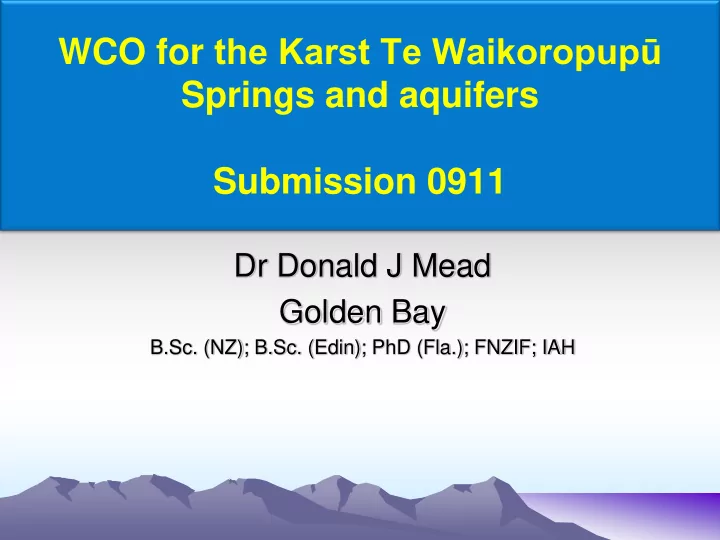

WCO for the Karst Te Waikoropupū Springs and aquifers Submission 0911 Dr Donald J Mead Golden Bay B.Sc. (NZ); B.Sc. (Edin); PhD (Fla.); FNZIF; IAH
Introduction • I will cover • The need for rigorous data analysis • Update results of the long-term GNS sampling of the Main Spring • Give a nitrate-N balance sheet for the AMA • Discuss dairy farming impacts since 1990 • Diiscuss setting pollution limits
Te Waikoropupū Springs NO 3 -N Nitrate-N data for Te Waikoropupu Main Spring 1.0 DSIR GNS Auto Analyzer Ion Exch. 0.8 ?? Nitrate-N (mg/l) Cawthron Legend 0.6 Cd reduction Nitrate-N Sen slope 0.4 0.2 GNS 0.0 1/1/70 1/1/80 1/1/90 1/1/00 1/1/10 Date • GNS checked when they changed methods – AA by hydrazine?? rather than Cd reduction method • AA by Ca reduction gives 15% higher results than IE • Followed Helsel & Hirsch (2002) recommendations on data use Cows in springs until the 1980s • Increasing nitrate concentrations, but care is needed
Updated analysis Nitrate-N in the Main Spring from Sept. 1994 on (excluding values >0.6 mg/l) 0.60 0.55 0.50 Legend Nitre-N (mg/l) 0.45 Nitrate-N 0.40 Median Sen slope Lowess (NO3) 0.35 0.30 0.25 0.20 1/1/94 1/1/97 1/1/00 1/1/03 1/1/06 1/1/09 1/1/12 1/1/15 1/1/18 Date The lowess trend line makes sense The Lowess trend explained over half the variation. Until 2005 it follows the Mann-Kendal trend of a gradual increase The bulge is associated with dairy farm intensification The dip may be due to dairy downturn plus better farm practices or ?
Nitrate balance study • Inputs to AMA using vegetation, and farms inputs – Unconfined aquifer plus allogenic recharge • Outputs via the Springs and Takaka River
Nitrate-N balance sheet 2017 Nitrate Inputs Area km 2 Land use t/ha NO 3 -N % Dairy farms 23.3 185 59 Other lowland pasture 6.4 10 3 Upland pasture 51.0 66 21 Gorse and broom 13.0 39 12 Forest/scrub etc 106.0 5 1 Other inputs 6.3 11 3 Total 206 316 100 Nitrate Outputs Te Waikoropupū Springs 173 50 Kotinga, Takaka river 170 50 Total 343 100 The upland input of 110 t NO 3 -N is similar to that calculated in the FoGB results.
Comments on this study • Methodology differs from Fenemor • The inputs are all indirect estimates – Uncertainty is high with some estimates – Boundaries sometimes are unclear • Outputs are better defined – However, different analytical techniques for nitrate-N • Underwater springs losses ignored because – We have incomplete knowledge of the AMA system – Downstream, the Takaka river nitrate partially enters the groundwater – At Lindsays Bridge nitrate is only a third of Kotinga
Lowland land-use changes over time Inputs Inputs Outputs t/year nitrate-N t/year nitrate-N Year Dairy Irrigated Lowland Dairy % dairy Pupu Takaka (ha) (ha) Springs River of lowland 1990 1400 91 102 67 65 126 NA 1995 1600 181 113 91 71 143 NA 2000 1900 181 129 102 79 152 61 2005 2300 547 158 137 87 156 118 2010 2325 709 188 167 89 185 170 2015 2325 1021 216 195 90 164 142
Setting pollution limits • There is high endemic biodiversity in the AMA and Springs • Bacteria and stygofauna are critical to maintain the water clarity • We do not know how sensitive these creatures are to nitrate-N. Their sensitivity to most potential toxins has yet to been studied. • Biota become adapted to the conditions they live under for long periods – we can expect them to be adapted to very low nitrate conditions.
• It is dangerous to extrapolate from studies of other creatures that live in different ecosystems • ANZEEC (2000) recommends that for water bodies with high conservation values and where little research has been undertaken, that levels be set at the current or natural level. • The National Policy Statement for Freshwater Management states that water quality is to be maintained or improved • The focus must be on protecting the aquifers and the Springs (as well as surface waters). – The surface and groundwater system are interconnected, but not well understood
• I strongly recommend that a precautionary approach be taken in setting the limits for nitrate, phosphate, clarity, dissolved oxygen etc • Limits are needed for other pollutants that could damage the ecosystems in the future. – I therefore support including schedule 5. • Example of the Edwards Aquifer in Texas (San Antonio) where first responders are specifically trained to deal with threats. • Further water abstraction, farm intensification and new land-uses should be required to show that they will not impact the AMA and Springs.
Conclusions • I strongly support the WCO and wish to see strong limits and controls to protect this complex system. • As stated on Section 3 of my report I have reviewed the range of options for protecting the AMA and Springs. – I concluded that a WCO was needed. • This review was presented to the IAH conference last year. The resulting paper has been accepted for publication.
Thank you – lets reduce this!
Recommend
More recommend